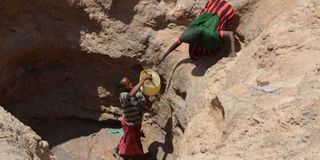Save Garissa from looming hunger

Residents in Geylab in Modogashe, Garissa County fetch water from a drying well. The current, sustained drought is billed to be the worst in 60 years, suggesting that the region is hurtling towards a famine crisis. FILE PHOTO | NATION MEDIA GROUP
What you need to know:
- It disrupts human life at many levels — depleted pasture, crippled food production and broken markets.
This risk is alive today in large swathes of the Horn of Africa and we feel it in very real terms in Garissa County.
The extreme poverty level, estimated at 71 per cent of the population, negatively affects every aspect of life.
Drought is, probably, the most devastating natural hazard known to humanity.
It disrupts human life at many levels — depleted pasture, crippled food production and broken markets, all leading to widespread loses in human and animal life.
Its impact, both social and economic, is often felt for generations.
This risk is alive today in large swathes of the Horn of Africa and we feel it in very real terms in Garissa County.
While the drought is not unique to us — as, indeed, government estimates show nearly three million Kenyans are severely food-insecure — two years of poor rainfall has us in a bad place.
MILK PRODUCTION
Daily milk production averages 1.7 litres per cow, down from 36 litres, as more than 70 per cent of the population report that their livestock manifest poor body conditions. Livestock have to move more than eight kilometres to get water.
The National Drought Management Authority (NDMA) says the October-December short rains were characterised by late onset, poor distribution and early cession in most of the 23 arid and semi-arid lands (Asal) counties.
The drought has caused depletion of pasture as most water points dry up while the few remaining ones have foul-smelling water. Even as the government pays their tuition fee, many students skip school for lack of food.
HEART-WRENCHING REPORTS
More heart-wrenching reports on exactly how this affects some households have come out graphically in my Thursday community engagement sessions.
Given that majority of Garissa residents are pastoralists, this state of affairs has dire implications on quality of life.
Yet the NDMA, in its latest bulletin, shows that the situation is deteriorating.
The county government has worked to connect residents, especially the most vulnerable, to emergency relief.
Many partners, such as the Kenya Red Cross and the national government, have been most forthcoming. But even bigger work is in realising long-term solutions.
SUSTAINED DROUGHT
Severe famine never comes suddenly or unexpectedly. The current, sustained drought is billed to be the worst in 60 years, suggesting that the region is hurtling towards a famine crisis.
We, in leadership, must create the policy environment that supports mitigation and save lives.
That is why in Garissa we are undertaking contingency plans, including distributing water through bowsers to all settlements. We are also rehabilitating water supply points and distributing collapsible tanks.
My government is seeking enhanced partnership with stakeholders in establishing coping mechanisms.
Early response saves lives and is relatively cheaper, but we must also work to deliver emergency relief, especially to women and children, who are the most vulnerable.
Families suffer alarming levels of food insecurity, further exposing them to harsh health risks.
Many Garissa residents have to walk dozens of kilometres to water sources. While the county government is investing in shortening these distances, emergency measures taken jointly with partners is beginning to make a difference in all sub-counties. But the burden is big.
EARLY WARNING, EARLY ACTION
Outside Garissa, two things need to happen. Our larger family of friends in the global community have been most helpful but we need to find ways for the bulk of this assistance to come to bear much earlier rather than when drought begets a famine crisis. The ambition is to have early warning matched with early action.
Secondly, we must work on national and county policies to help to deal with these situations before they become acute. Integrated programmes, including drought-resistant crops and breeds, is on the agenda. Our Livestock and Agriculture department has moved fast in deworming and vaccination of animals against diseases.
Creative ways to manage bureaucracy and clarity on sanctity of life shall guide us as we assign limited resources to competing interests.
DEVELOPMENT GAP
Truth be told, the social situation in the county is grave on any measure of human development.
Garissa has always had a development gap to ponder.
The extreme poverty level, estimated at 71 per cent of the population, negatively affects every aspect of life.
This is why being subjected to an extended drought punishes more and also why we must bring on board science and long-term policy to help us to respond.
This challenge of nature is a distraction from Garissa’s stellar match to contribute to Kenya’s growth story under the Jubilee administration, as witnessed in the commencement of the largest solar plant in East and Central Africa just weeks ago — the 54.65MW Garissa Solar Plant. But we shall stay the course.
Mr Korane is the governor of Garissa County. Twitter: @HonAliKorane





